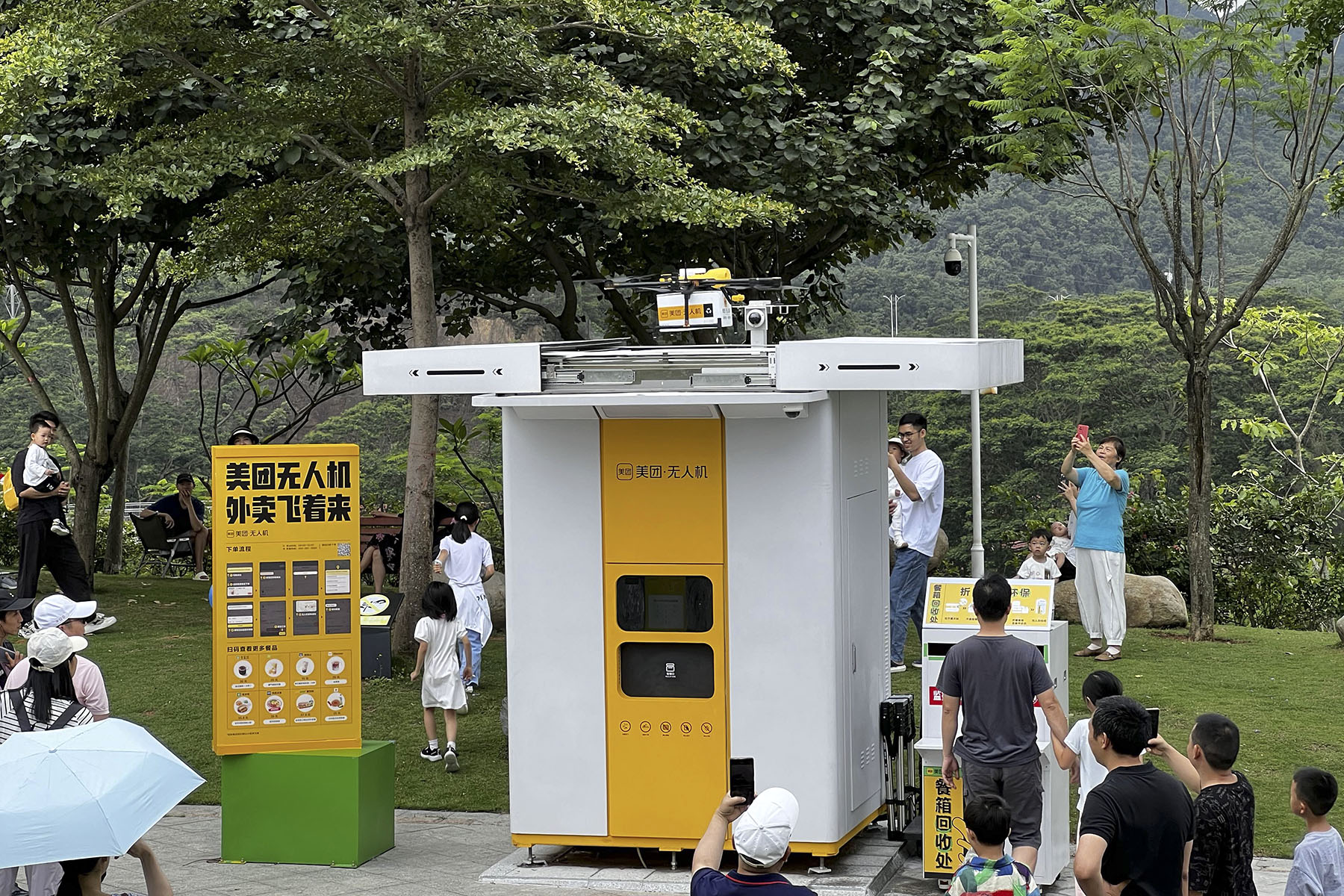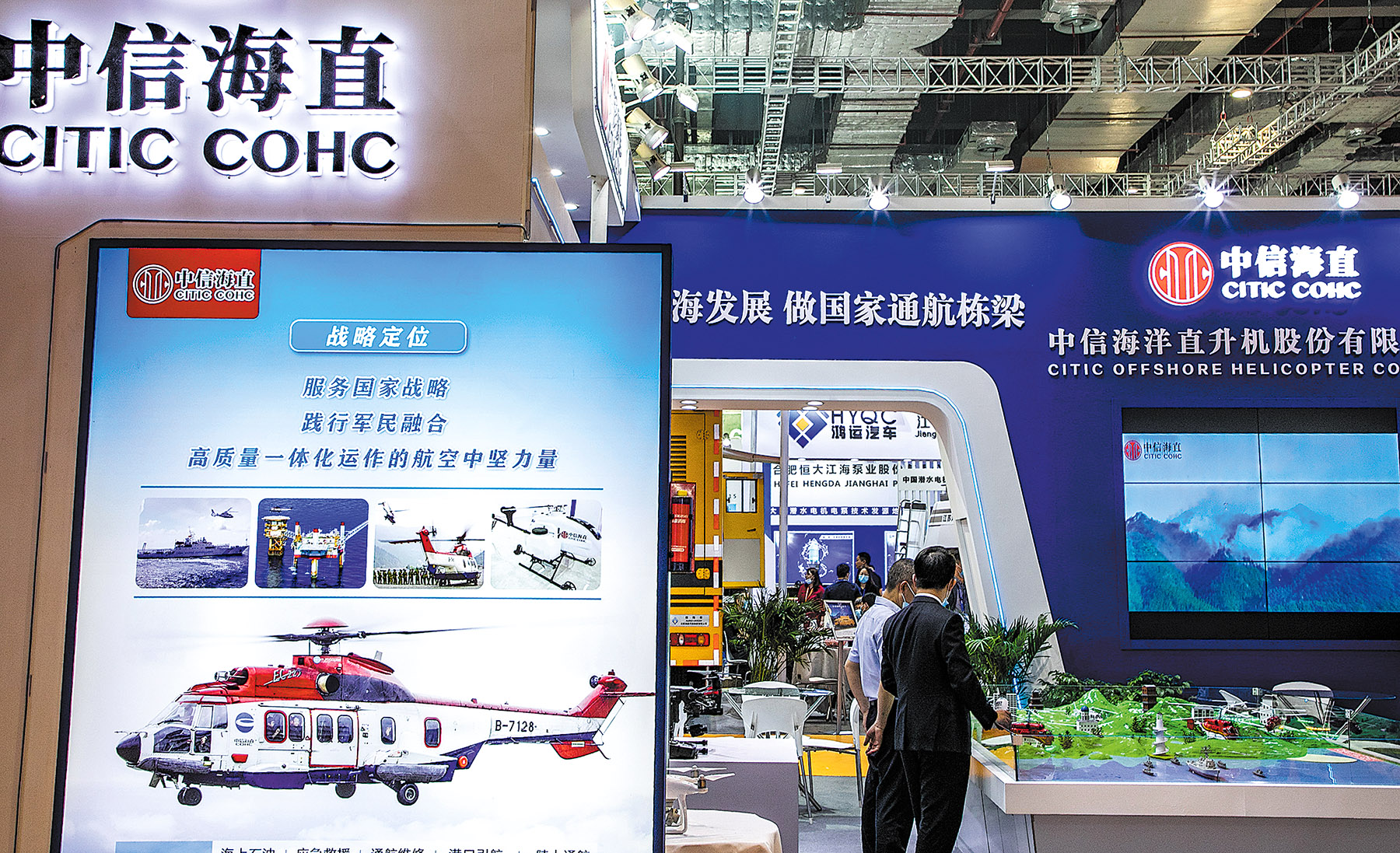Domestic tech giants see bright future prospects on rising use of pilotless flights

In late May, an unmanned aerial vehicle belonging to online services platform Meituan soared through the air, navigating its way to a designated drop-off point in Shenzhen Talent Park, Guangdong province, which sits in close proximity to the headquarters of such tech giants as Tencent, Alibaba and Baidu.
It seamlessly docked at its intended pad, efficiently placing a food order into a specially designed storage compartment. As one drone completed its delivery, another drone took off, ready to embark on a new airborne mission to satiate appetites and quench thirst.
"I ordered a Starbucks beverage valued at 36 yuan ($4.96), which typically costs 39 yuan when ordered in person," said Cheng Zhe, a 28-year-old coder who opted to try out a drone delivery, adding that he not only saved a few yuan, but also enjoyed the added benefit of free delivery.
READ MORE: Shenzhen goes above and under
The application of drones in the delivery sector is just a fraction of the broader low-altitude economy. As the airspace opens up in a well-paced manner, a wide range of industries and sectors are exploring the possibility of utilizing UAVs for various purposes.
According to a report by the China Center for Information Industry Development released in April, China's low-altitude economy, worth 505.95 billion yuan in 2023, registered a year-on-year growth rate of 33.8 percent that year.
As the sector continues to expand along with improved infrastructure, it is poised to exceed the trillion-yuan mark by 2026, the report noted.
The low-altitude economy comprises 85 percent UAVs and 15 percent general aviation, said Yang Jincai, director of the Shenzhen Unmanned Aerial Vehicle Industry Association in Guangdong.
This emerging sector is a dynamic and creative one that operates below an altitude of 1,000 meters, with the possibility of extending to 3,000 meters under special circumstances, presenting a wide range of applications and operational scenarios, Yang said.
The development of the low-altitude economy has been constrained by airspace regulations. Taking Meituan's drone delivery service as an example, drones are required to fly along predetermined routes at a maximum height of 120 meters, limiting their operations to designated areas.
In response to this challenge, the Civil Aviation Administration of China announced plans in late May to collaborate with relevant departments to initiate airspace classifications and low-altitude airspace management reforms, aiming to increase the availability of airspace for low-altitude operations.
The low-altitude economy is now making its way into everyday life, driven by the use of drones to enhance visitor experience in the tourism sector.
Traditional food delivery services often face challenges when it comes to accessing scenic areas due to restrictions. This inconvenience has forced visitors to walk considerable distances to collect their orders, said Yang.
By utilizing drones, visitors can have their orders delivered directly to them within the park, eliminating the need for long walks to the entrance. This efficient delivery service has quickly become a popular and highly sought-after experience among tourists, Yang added.
Apart from the convenience of food delivery services, these aircraft are increasingly being employed to provide aerial tours, showcasing scenic areas from a unique vantage point, offering tourists an immersive and unforgettable experience.
Luogang Park in Hefei, Anhui province, once an airport, has undergone transformation into the world's largest urban park. In addition to its scenic beauty, the park has become a prime location for the application of the low-altitude economy, particularly in the tourism and sightseeing sectors.
Chinese urban air mobility company EHang Holdings Ltd conducts daily flight tests of its passenger-carrying drones within the park, with plans underway for commercialization. Luogang Park aims to establish internal air routes and develop "aerial taxi" hubs, allowing visitors to purchase tickets and enjoy panoramic views of the park from above.

According to recent data released by the CAAC, approximately 480,000 visits related to aerial sightseeing were made in 2022. Moreover, the administration estimates that the low-altitude economy in the tourism sector is poised to exceed 200 billion yuan by 2030.
Exploring potential applications in sectors beyond tourism — such as logistics, agriculture, environmental monitoring and infrastructure inspections — is crucial for the growth and sustainability of the low-altitude economy, analysts said.
By diversifying the use of low-altitude technology, businesses can unlock new revenue streams and contribute to the growth of the overall industry, said Bai Wenxi, vice-chairman of the China Enterprise Capital Union.
Unmanned aerial vehicles can be effectively employed in various sectors such as maritime security, surveillance, fishery patrols, forest inspections and oil pipeline monitoring, which capitalizes on the unique capabilities of drones to gather and transmit data from elevated positions, Bai said.
In addition, UAVs are particularly relevant for applications that require rapid and efficient delivery, such as medical supplies, urgent cargo shipments and emergency response services, Bai added.
In May, CITIC Offshore Helicopter commenced operations on a helicopter route between Shenzhen and nearby Zhuhai. The new service offers passengers an efficient alternative to the traditional two-hour land journey, completing the trip in just 20 minutes. Priced at 999 yuan per ticket, the helicopter service has attracted a group of time-conscious travelers who prioritize speed over cost.
The development of the low-altitude economy relies heavily on advanced aerial vehicles and the support of information technology, network connectivity and communication systems.
The general aviation manufacturing industry plays a crucial role in providing the necessary equipment for growth of the low-altitude economy, said Shan Zhongde, China's vice-minister of industry and information technology.
China had more than 2,300 domestic companies engaged in civilian drone research and development by the end of 2023, with more than 1,000 drone models mass-produced, Shan said, adding that last year, China delivered more than 3.17 million civilian drones.
With a comprehensive supply chain encompassing R&D, component manufacturing, assembly and distribution, China has positioned itself as a global leader in drone production, said Tian Gangyin, founder and CEO of United Aircraft.
ALSO READ: Eye in sky nets big fame for village
The vast network of suppliers, manufacturers and tech companies has contributed to the country's ability to deliver high-quality drones at competitive prices, Tian said, adding that China has played a pivotal role in shaping international standards for drone technology.
A future where multiple aerial vehicles, both manned and unmanned, operate in close proximity, requires precise coordination and communication to ensure safety and maximize airspace utilization, experts said.
The vision of achieving end-to-end and door-to-door services in the low-altitude economy requires the establishment of robust infrastructure capable of supporting high-precision operations, said Li Xiaohua, a researcher at the Institute of Industrial Economics, which is part of the Chinese Academy of Social Sciences.
This infrastructure includes a network of sensors, communication systems and intelligent devices that work together seamlessly to ensure smooth and efficient operations across the entire airspace, Li said.
The low-altitude traffic system will realize more intelligent operational management, real-time monitoring and intelligent scheduling of low-altitude economic activities, gradually improving operational efficiency and management standards, Li said, adding that with such a network in place, regulatory agencies can effectively monitor and control low-altitude flights, ensuring a safe and well-regulated airspace environment.


